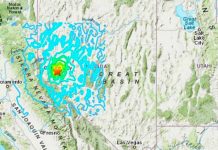Dec. 23 (UPI) — California regulators are considering breaking up Pacific Gas & Electric Co. or turning it into a public utility in the wake of deadly disasters, including the Camp Fire, in northern California.
On Friday, the California Public Utilities Commission said it is seeking as part of its mission to “empower California through access to safe and affordable utility services and infrastructure,” according to a news release about the 16 million customers served in the northern portion of the state.
That will include whether PG&E’s board and executive management should be replaced as an effort “to determine the best path forward for Northern Californians to receive safe energy service.”
Possibilities also include reorganizing the corporate structure with subsidiaries based on regional distinctions, splitting it into gas and electric operations, removing PG&E as an exclusive utility and changing it to a publicly owned utility.
“We must be careful and practical,” CPUC President Picker said. “This process will be like repairing a jetliner while it’s in flight. Crashing a plane to make it safer isn’t good for the passengers.”
The next step is for the CPUC to obtain input on the various possible approaches with opening comments due Jan. 30.
In addition, CPUC wants to develop methodology for utility requests for wildfire cost recovery.
“This is not a punitive exercise,” Picker said. “The keystone question is would, compared to PG&E and PG&E Corp. as presently constituted, any of the proposals provide Northern Californians with safer natural gas and electric service at just and reasonable rates.”
CPUC noted “serious safety problems with both its natural gas and electric operations in recent years.”
California regulators are investigating whether PG&E continued to commit pipeline safety violations and falsified records eight years after an explosion killed eight people in the San Francisco Bay Area.
In 2015, the CPUC opened a proceeding to determine whether PG&E’s and PG&E Corp.’s organizational culture and governance prioritize safety. The CPUC adopted the safety findings and recommendations of its Safety and Enforcement Division contained in the Northstar Report in November.
The utility also has been confronted with billions of dollars of claims stemming from last year’s deadly Northern California fires.
PG&E also is facing class-action suits that it sparked the Camp Fire, which killed 86 people last month in Northern California. The fire started on Nov. 8 in Butte County, and became the most deadly and destrucive in state history. The suits include victims of the fire.
The utility could file for bankruptcy.
In a statement late Friday, the company that it needed to “re-earn” the trust of its customers because state regulators have serious concerns about the utility.
“The company’s board of directors and senior management team have been actively exploring additional changes beyond the corrective actions and new programs we’ve implemented at the operational level,” PG&E said. “Our shared goal is to improve our culture and practices that will more fully reinforce our commitment to safety, integrity and risk reduction.”
On Friday, the California Public Utilities Commission said it is seeking as part of its mission to “empower California through access to safe and affordable utility services and infrastructure,” according to a news release about the 16 million customers served in the northern portion of the state.
That will include whether PG&E’s board and executive management should be replaced as an effort “to determine the best path forward for Northern Californians to receive safe energy service.”
Possibilities also include reorganizing the corporate structure with subsidiaries based on regional distinctions, splitting it into gas and electric operations, removing PG&E as an exclusive utility and changing it to a publicly owned utility.
“We must be careful and practical,” CPUC President Picker said. “This process will be like repairing a jetliner while it’s in flight. Crashing a plane to make it safer isn’t good for the passengers.”
The next step is for the CPUC to obtain input on the various possible approaches with opening comments due Jan. 30.
In addition, CPUC wants to develop methodology for utility requests for wildfire cost recovery.
“This is not a punitive exercise,” Picker said. “The keystone question is would, compared to PG&E and PG&E Corp. as presently constituted, any of the proposals provide Northern Californians with safer natural gas and electric service at just and reasonable rates.”
CPUC noted “serious safety problems with both its natural gas and electric operations in recent years.”
California regulators are investigating whether PG&E continued to commit pipeline safety violations and falsified records eight years after an explosion killed eight people in the San Francisco Bay Area.
In 2015, the CPUC opened a proceeding to determine whether PG&E’s and PG&E Corp.’s organizational culture and governance prioritize safety. The CPUC adopted the safety findings and recommendations of its Safety and Enforcement Division contained in the Northstar Report in November.
The utility also has been confronted with billions of dollars of claims stemming from last year’s deadly Northern California fires.
PG&E also is facing class-action suits that it sparked the Camp Fire, which killed 86 people last month in Northern California. The fire started on Nov. 8 in Butte County, and became the most deadly and destrucive in state history. The suits include victims of the fire.
The utility could file for bankruptcy.
In a statement late Friday, the company that it needed to “re-earn” the trust of its customers because state regulators have serious concerns about the utility.
“The company’s board of directors and senior management team have been actively exploring additional changes beyond the corrective actions and new programs we’ve implemented at the operational level,” PG&E said. “Our shared goal is to improve our culture and practices that will more fully reinforce our commitment to safety, integrity and risk reduction.”






